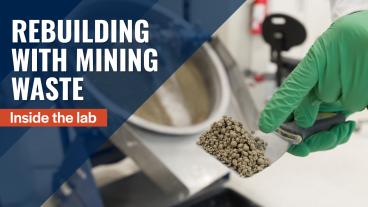Hydraulic fracturing generates billions of gallons of wastewater every year in the U.S. and determining the quality and chemical composition of that water continues to pose a challenge for scientists.
A Colorado School of Mines doctoral student and professor hope their newly published findings could help push that much-needed analysis forward amid recent suggestions that these waters, once treated, could be a potential resource in areas where water is otherwise scarce.
“There’s a lot that we know but there’s also a lot that we don’t know about this wastewater because of the state of our analytical methods,” said Karl Oetjen, a doctoral candidate studying hydrology at Mines.
“If you’re worried about introducing this water to places where it could interact with the environment or human health, it’s impossible to say if it’s dangerous or not dangerous because we simply don’t know.”
Oetjen and Mines Civil and Environmental Engineering Associate Professor Chris Higgins laid out their findings in a paper published this month in Trends in Environmental Analytical Chemistry. Also contributing to the study were researchers from Colorado State University, Cornell University and the Environmental Defense Fund.
“This paper is important in that it outlines what we should be doing to characterize these potentially problematic compounds in these waters,” Higgins said.
The team found that many existing characterization methods designed for the study of surface and groundwater may not be suitable for the wastewater produced during hydraulic fracturing because of its salinity and chemical complexity.
Currently, the wastewater is largely disposed of, either in pits, through evaporation or via reinjection deep into the earth. The water can contain large amounts of dissolved solids, various hydrocarbons, organic acids, alcohols, radionuclides and metals, as well as synthetic additives including surfactants, gels, scale inhibitors, biocides and friction reducers. It’s also very salty – produced waters can have salinities similar to or much greater than seawater, Oetjen said.
Less than a quarter of the more than 1,600 chemicals associated with hydraulic fracturing have approved analytical methods, according to the study. The fracturing process itself, with its high pressure and temperatures, can also have a transformative effect on synthetic chemicals, Oetjen said.
“A lot of times we’re not really sure what to look for,” Oetjen said. “What comes up hole might not be what went down hole.”
Among the ideas that have been floated for what to do with treated wastewater are irrigation and discharge into streams.
Before any of that could happen, though, scientists need to get a better grasp on what’s in the water, which returns to the surface as part of the fracturing process, Oetjen said.
The study suggests using non-target methods that can cast a wide net for possible compounds as opposed to specific targeting. Any new analytical methods should also be thoroughly validated to ensure they are sufficiently sensitive and robust.
Funding for the study was provided by the Environmental Defense Fund and the ConocoPhillips Center for a Sustainable WE2ST at Colorado School of Mines.
“If we can better understand what’s in these waters, the treatment can be a little easier,” Oetjen said. “It’s a lot of water. Especially in an area like Colorado where we are water-limited, it could be a valuable resource.”
CONTACT
Emilie Rusch, Public Information Specialist, Communications and Marketing | 303-273-3361 | erusch@mines.edu
Mark Ramirez, Managing Editor, Communications and Marketing | 303-273-3088 | ramirez@mines.edu



